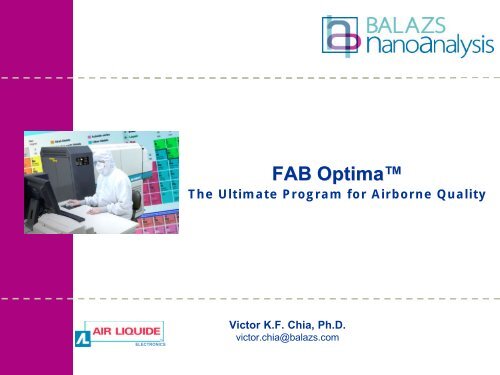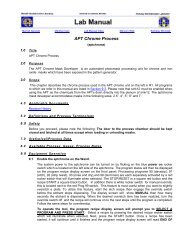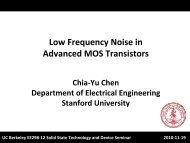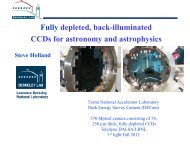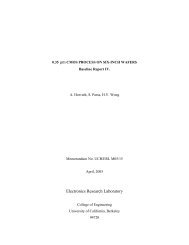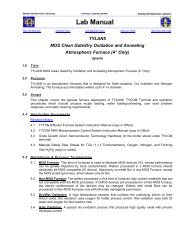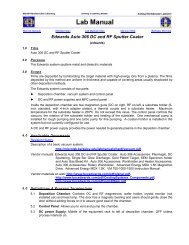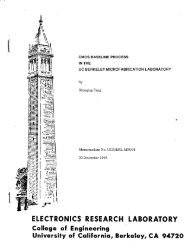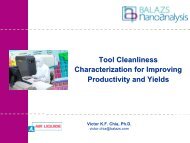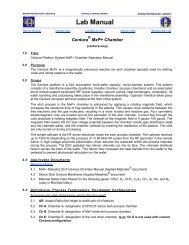Fab Optima - Berkeley Microlab
Fab Optima - Berkeley Microlab
Fab Optima - Berkeley Microlab
Create successful ePaper yourself
Turn your PDF publications into a flip-book with our unique Google optimized e-Paper software.
ELECTRONICS<br />
FAB <strong>Optima</strong> <strong>Optima</strong><br />
The Ultimate Program for Airborne Quality<br />
Victor K.F. Chia, Ph.D.<br />
victor.chia@balazs.com
Abstract<br />
<strong>Fab</strong> <strong>Optima</strong> TM : The Ultimate Program for Airborne Quality<br />
The <strong>Fab</strong> airborne quality is an essential building block for clean manufacturing.<br />
The construction materials and all materials within the cleanrooms affect the fab<br />
airborne quality. <strong>Fab</strong> <strong>Optima</strong> is a Quality Control process that ensures the facility<br />
is capable of supporting clean manufacturing for increased production yields. This<br />
can only be achieved through collaboration between facility engineers,<br />
contamination control engineers and process engineers working in concert to<br />
lower the risk of contamination that often results in fab and tool escalations. This<br />
presentation reviews the key components of the program with examples of<br />
monitoring programs, Recommended Practices and test results.<br />
Verify Root<br />
Cause<br />
Partitioning<br />
Test<br />
Reducing Contamination<br />
Escalation<br />
Contamination<br />
Identification<br />
Speaker Biography: Victor Chia is a Director of Air Liquide-Balazs Analytical<br />
Services. His responsibilities include advancing surface contamination<br />
technologies at Balazs, global sales and international business development.<br />
Victor has served in the semiconductor industry for over 20 years. He received<br />
his Ph.D. in Analytical Chemistry from the University of California, Santa Barbara<br />
and was a post-doctoral fellow at Lawrence <strong>Berkeley</strong> Laboratory. Victor has<br />
hands-on experience with AAS, Raman Spectroscopy and SIMS. He is the current<br />
chair of the IEST WG-031 for organic outgassing and is active with AVS at the<br />
National and Chapter level committees, as well as the standard committee of the<br />
ITRS. Victor has held positions at KLA-Tencor (Contamination Specialist) and at<br />
Charles Evans and Associates (11 years starting as SIMS analyst to Director). Dr.<br />
Chia was also the President of Cascade USA, a branch of Cascade Scientific and<br />
worked as a Consultant. Victor has published over 40 papers and co-authored<br />
several chapters on SIMS and contamination characterization. Victor is an<br />
experienced instructor and has presented several UC <strong>Berkeley</strong> Extension Courses.
Outline<br />
Introduction<br />
AMC baseline, source and control<br />
• MA, MB, MC, MD, MM<br />
• Test methods<br />
SMC baseline, source and control<br />
• SMO, SMD.SMM<br />
<strong>Fab</strong> <strong>Optima</strong> TM (Optimization for Manufacturing)<br />
StarALert programs for clean manufacturing<br />
Personal behavior<br />
Cleanroom practice<br />
Cleanroom supplies<br />
Cleanroom housekeeping<br />
Cleanroom cleanliness validation<br />
Cleanroom monitoring program<br />
Case studies<br />
Reducing Contamination
Airborne Molecular Contamination (AMC)<br />
MA Molecular Acids HCl, HF, HNO 3 , H 2 SO 4<br />
MB Molecular Bases Ammonia, amines, amides<br />
MC Molecular Condensables Organics: silicones,<br />
plasticizers (bp >150°C)<br />
MD Molecular Dopants B, P, As compounds<br />
MM Molecular Metals Al, transition metals, alkali<br />
Volatility (vapor pressure)<br />
AMC can pass through HEPA and ULPA filters into cleanrooms<br />
Boiling points<br />
Typically, < ~ 450 o C organics can eventually pass through ULPA or gas<br />
filters<br />
AMC can become SMC (Surface Molecular Contamination)<br />
SMC can form many particles<br />
If > monolayer, SMC can make films, homogeneous or islands<br />
SMC is often < ML (~5Å) or approximately 10 15 atoms or ions/cm 2<br />
Reducing Contamination
AMC Sources AMC Effects<br />
Outside air: autos, power plants, smog,<br />
industry, roofing, paving, fertilizers,<br />
pesticides, farming, sewers, fab exhaust,<br />
ocean/saline water<br />
Process chemicals (esp. hot), reaction byproducts,<br />
reactor exhaust<br />
Wet cleaning, wet- and dry-etching,<br />
electroplating baths<br />
Solvents: lithography, cleaning solutions<br />
People: ammonia, sulfides, organics<br />
Equipment outgassing: robots, motors,<br />
pumps, fans,<br />
electronics, computers, heaters<br />
Materials outgassing into air or onto<br />
sealed products<br />
Disasters, internal or external:<br />
Spills, leaks (coolants), accidents,<br />
fires, power outages<br />
Failures of air handlers and scrubbers<br />
Recirculating air between areas<br />
FOUPs, Pods, shippers, carriers,<br />
minienvironments<br />
Reducing Contamination<br />
DUV photoresist T-topping<br />
Uncontrolled boron or phosphorus doping<br />
Surface issues: adhesion, wafer bonding,<br />
delamination, electrical conductivity, high<br />
contact resistance, shorts,<br />
leakage currents, wetting, cleaning, etch<br />
rate shifts, spotting, particle removal,<br />
electroplating defects<br />
Wafer hazing: time dependent haze<br />
Optics hazing: hazing by adsorption,<br />
reactions, etching or photochemistry on<br />
lenses, lasers, steppers, masks, reticles,<br />
pellicles - especially for 157 and 193 nm<br />
lithograpghy<br />
Corrosion: process wafers (Al, Cu), flat<br />
panel displays,<br />
equipment, instruments, wiring and<br />
facility (over many years)<br />
SiC/Si 3 N 4 formation following preoxidation<br />
clean<br />
Threshold voltage shifts<br />
Nucleation irregularities
AMC and SMC Sampling/Test Methods<br />
AMC-MA: Anion - air sampler/IC<br />
AMC-MB: Amines/ammonia - air sampler/IC<br />
AMC-MD: Phosphate ions - air sampler/IC<br />
AMC-MD: B and P - air sampler/ICP-MS<br />
AMC-MM: Metals - air sampler/ICP-MS<br />
Air Bubbler<br />
Pump/Adsorbent<br />
AMC-MC: Amides and organic compounds -<br />
absorbent tube and TD GC-MS<br />
Reducing Contamination<br />
Fused Silica (8h sampling)<br />
Witness Wafer<br />
SMC-SMA: Wafer - UPW extraction/IC<br />
SMC-SMB: Wafer - UPW extraction/IC<br />
SMC-SMOrg: Wafer - FW TD-GC-MS<br />
SMC-SMD: Wafer - VPD ICP-MS<br />
SMC-SMM: Wafer - VPD ICP-MS & TXRF<br />
AMC-MD: B and P - wafer/VPD ICP-MS<br />
AMC-MM: Metals - wafer/VPD ICP-MS
AMC Monitoring (I)<br />
Incoming wafers<br />
Organics, condensables, dopants, and metals on the wafer surface<br />
New cleanroom materials (contruction and consumables)<br />
Organic outgas testing (including organophosphate dopants)<br />
Make-up air (MUA)<br />
Organics, acids, and bases prior to recirculation to check for<br />
outside environmental sources<br />
Stockers, mini-environments, wafer sort and storage areas<br />
Acids and ammonium in air (amines if used in the fab)<br />
Organics and dopants on wafers<br />
Reducing Contamination
AMC Monitoring (II)<br />
Pre-diffusion, oxidation furnace, implant annealing process<br />
areas<br />
Dopants, metals, and alkali on witness wafers<br />
Acids in air (cause corrosion)<br />
Lithography process areas<br />
Air and gases including CDA, N 2, Ar, O 2 and He<br />
• Acids, bases, and condensables<br />
• Up-stream and down-stream of carbon filters/purifiers<br />
Wet bench and bath areas<br />
Bases, amines, amides and organics<br />
in air<br />
Acids and ammonium in air (amines<br />
if in photoresist strippers)<br />
Reducing Contamination<br />
Cl-induced corrosion of Al at the bottoms<br />
of vias.
Molecular Acids (AMC-MA)<br />
NO x dominant MA and is<br />
not removed by filters. Not<br />
as detrimental as other<br />
acids. NO x compounds<br />
often “smog” related<br />
Most acids are from SC-2,<br />
HF, BOE, SPM), RIE, CVD,<br />
dopants (POCl 3 )<br />
PO 4 3- very rare since<br />
phosphoric acid not<br />
volatile. POCl 3 leaks can<br />
put P into air.<br />
SO 4 2- can come from inside<br />
air or outside air (SO 2 )<br />
which can oxidize to<br />
sulfates<br />
Reducing Contamination<br />
% of sites within range<br />
100%<br />
90%<br />
80%<br />
70%<br />
60%<br />
50%<br />
40%<br />
30%<br />
20%<br />
10%<br />
0%<br />
Baselining Molecular Acids in Cleanroom Air<br />
Typical US SEMI Cleanrooms<br />
< 100 100 to 1000 >1000<br />
Range (pptM)<br />
Br-<br />
Cl-<br />
NO3(-)<br />
NO2(-)<br />
PO4(3-)<br />
SO4(2-)
Sources of Molecular Acids<br />
Cleaning and acid etch baths (process lines and wet laboratories<br />
in fabs)<br />
Vaporization of H 2 + SO4 2 -, H + Cl - , H + F - , H3 + PO4 3- , and H + NO3 -<br />
Problems occur when there is insufficient exhaust<br />
Improper airflow setting of minienvironment used for acid sinks<br />
Typical cleanroom H 2SO 4 concentrations are
Ionic Haze - Background<br />
Dominion Semiconductor was the first to report yield loss from<br />
ammonium sulfate haze around 1997, when the company lost<br />
some $25M in one day<br />
Since then, essentially every semiconductor fab has experienced<br />
some form of haze contamination<br />
In some cases, the loss actually outstripped revenue, with the<br />
largest loss reported to date being $100M<br />
The worst effects have been seen in Taiwan and Shanghai, China,<br />
where environmental factors figure prominently<br />
In addition to ionic haze, the surfactants that maskmakers use to<br />
clean the photomasks are a significant cause of haze<br />
Reducing Contamination
Ionic Haze<br />
L.W. Shrive, R.E. Bank, and K.H. Lamb,<br />
MICRO, p. 59, March 2001<br />
Experiment<br />
Different volumes of water was added<br />
to wafer carriers containing freshly<br />
cleaned wafers<br />
The total area of the wafers that is<br />
affected by haze can be related to the<br />
amount of water added<br />
Oxide thickness increased from 0.8 -<br />
1.1 nm (clean wafer) to a chemical<br />
oxide thickness of 1.5 nm<br />
Wafer maps at MEMC<br />
showed that packaging<br />
issues were causing the<br />
growth of haze on wafers<br />
placed in storage. In this<br />
case, a rough estimate puts<br />
particle density at more<br />
than a million defects per<br />
square centimeter.<br />
Reducing Contamination<br />
The causes of haze are generally from<br />
insufficient rinsing and AMC<br />
Stable Haze<br />
Haze formation caused by a high<br />
concentration (≥ 10 14 - 10 15 atoms/cm 2 )<br />
of any anions and cations on the Si<br />
surface. For example ammonium chloride<br />
or ammonium sulfate residues.<br />
Ammonium sulfate haze<br />
This haze is stable since there are<br />
equivalent amounts of anions & cations<br />
The suspected causes are from poor<br />
rinsing of wafers after chemical cleans<br />
and inadequate exhaust at wet benches
Ionic Haze (cont’d)<br />
Time dependent haze (TDH)<br />
These hazes are difficult to identify as they<br />
appear and disappear with time<br />
+<br />
It is due to excess NH4 ions on a Si wafer;<br />
anions concentration do not balance the<br />
+<br />
concentration of NH4 ions detected<br />
+<br />
The excess NH4 ions are probably present as<br />
a condensed film of NH4OH or a solution NH3 in H2O The haze is not stable since NH 4OH is<br />
extremely volatile and appears/disappears<br />
depending on the temperature and humidity of<br />
the Si wafer environment<br />
Reducing Contamination<br />
Optical and SEM images show ammonium<br />
carbonate haze formation.<br />
Ion Chromatography (IC)<br />
Cations<br />
+ + + + + - - - - -<br />
Silicon Wafer<br />
Time-dependent haze (TDH), also known as degradation haze, is formed in the following way:<br />
The wafer is contaminated with water-soluble ions and organic molecules (other organic<br />
molecules also deposit on the wafer, making it more hydrophobic).<br />
A change in humidity causes water to condense on the wafer surface.<br />
The surface water dissolves the water-soluble contaminants<br />
The hydrophobic surface causes the water to form microscopic droplets.<br />
The micro-droplets evaporate and leave residual TDH defects.<br />
Without humidity, micro-contamination does not develop into haze. So one thing MEMC did<br />
was to implement measures to get the moisture out of its manufacturing<br />
Anions
Ionic Haze (cont’d)<br />
Fluoride haze<br />
High concentrations of fluoride ions can cause uneven etching of the<br />
native oxide and give the appearance of a haze<br />
Potential contamination sources of F- ions are wafer carriers and<br />
boxes; either through direct contact or outgassed F- ions, from DI<br />
water or process chemicals with high F- ions concentration, and from<br />
F- ions leached from flouropolymer components<br />
AFM<br />
Reducing Contamination<br />
Pits<br />
Surface Roughness<br />
Silicon Wafer<br />
FE-AES, SARIS,<br />
SEM-EDS, XPS<br />
Silicon Wafer<br />
Particles
Passive Impinger<br />
Low Cost alternative ($30 for PFA<br />
Teflon Pot) to active impingers<br />
Impingers are filled with UPW that<br />
has undergone additional<br />
polishing with a Millipore Element<br />
system<br />
No acids or solvents are used as<br />
the collection media<br />
Impingers are placed in each<br />
process bay and left for 1 week<br />
period<br />
After 1 week PIs are collected,<br />
weighed and analyzed via ion<br />
chromatography (IC)<br />
Reducing Contamination<br />
PFA teflon<br />
passive<br />
impinger<br />
Luke Lovejoy, Motorola,<br />
2nd Annual SCCCM Conference, San Marcos, TX, 2003
AMC-MA/MB/MM Using UPW Impinger<br />
Normalized<br />
ng/50cm2/weel<br />
6,900<br />
5,900<br />
4,900<br />
3,900<br />
2,900<br />
1,900<br />
900<br />
Reducing Contamination<br />
Passive Impinger Data<br />
(100)<br />
0<br />
12/10/0 1/29/03 3/20/03 5/9/03 6/28/03 8/17/03 10/6/03<br />
2<br />
Date<br />
60000<br />
50000<br />
40000<br />
30000<br />
20000<br />
10000<br />
Normalized<br />
(Fluoride)<br />
ng/50cm2/week<br />
Chloride<br />
Bromide<br />
Nitrate<br />
Phosphate<br />
Sulfate<br />
Lithium<br />
Sodium<br />
Ammonium<br />
Potassium<br />
Magnesium<br />
Calcium<br />
Fluoride<br />
Luke Lovejoy, Motorola, 2nd Annual SCCCM Conference, San Marcos, TX, 2003
Controlling Molecular Acids<br />
Improved balancing of wet benches, reactors, exhaust<br />
Exhaust scrubbing, dilute chemistries, closed area cleans<br />
Gas phase adsorbers (e.g. Na 2 CO 3 , KOH, IX resins)<br />
For outside air (NO x, SO x)<br />
For recirculation air (to remove process acids)<br />
Isolation of processes (from cross-contamination)<br />
Reducing Contamination
Molecular Bases (AMC-MB)<br />
Amines are seldom<br />
observed, unless used (e.g.<br />
photoresist stripper,<br />
humidifiers)<br />
Ammonia still remains the<br />
dominant base in fabs<br />
Amides as NMP sometimes<br />
seen if used<br />
“Water spotting” has been<br />
observed to result from<br />
excessive base ambient<br />
Probably results from<br />
caustic etching causing<br />
increased microroughness<br />
from sodium silicate<br />
formation<br />
Reducing Contamination<br />
% of sites in each range<br />
100%<br />
90%<br />
80%<br />
70%<br />
60%<br />
50%<br />
40%<br />
30%<br />
20%<br />
10%<br />
0%<br />
Baselining Molecular Acids in Cleanroom Air<br />
Typical US SEMI Cleanrooms<br />
< 100 100 to 750 750 to 10,000 10,000 to<br />
Range (pptM)<br />
NH3 (as NH4+ by IC)<br />
Amines by IC<br />
NMP by GC-MS<br />
100,000<br />
100,000 to<br />
2,000,000
Sources of Molecular Bases<br />
Ammonia (NH 3 )<br />
HMDS, CMP slurries/wafer polishing, wafer cleaning (SC-1, APM),<br />
Si 3N 4 and TiN deposition, people, outside air (especially fertilizer,<br />
sewers, farms)<br />
Amines (NR 3 )<br />
Photoresist strippers<br />
Cleaning solutions<br />
Anion exchange resin regeneration (Me 3N) epoxies<br />
Air humidifiers (corrosion inhibitors)<br />
Amides (R-C=O(-NR 2 )<br />
Photoresist strippers<br />
Solvents for polymers, including polyimides, epoxy<br />
High-temperature solvent baths<br />
Paints and paint removers (NMP, 1-methyl-2-pyrrolidine)<br />
Reducing Contamination
Controlling Molecular Bases<br />
Source reduction<br />
Improved venting of baths and scrubbing of exhaust<br />
Amine/base removal<br />
Appropriate gas phase or carbon adsorber cells (molecular filters) in<br />
lithography area. Such as, citric acid, phosphoric acid, acidic polymers<br />
and Activated Carbon to remove NMP & high boiling organics<br />
Need to test kinetics (breakthrough), capacity (lifetime), shedding<br />
(contamination)<br />
Isolation<br />
Purge tracks and minienvironments (MENV) with base filters or<br />
purified gases<br />
Modify process<br />
Shorter process windows prior to resist coat and post exposure<br />
Pre-exposure bakes to densify/harden resist and reduce base<br />
penetration or diffusion<br />
Reducing Contamination
Molecular Condensable (AMC-MC)<br />
Plasticizers<br />
TXIB, bp 280 o C<br />
(Texanol isobutyrate)<br />
O<br />
O<br />
O<br />
(Dioctyl phthalate)<br />
O O O<br />
O<br />
Reducing Contamination<br />
O<br />
DOP, bp 384 o C<br />
Phosphates<br />
TEP, bp 215 o C<br />
(Triethyl phosphate)<br />
O<br />
O P O<br />
O<br />
PDMS<br />
Poly(dimethyl silicone)<br />
Silicones / Siloxanes<br />
CH 3 CH 3 CH 3<br />
CH 3-Si-O-Si-O-Si-CH 3<br />
CH 3 CH 3 CH 3<br />
Antioxidants<br />
BHT, bp 233<br />
(Butylated hydroxytoluene)<br />
oC Decamethylpentasiloxane<br />
Si O<br />
Si<br />
O<br />
Si<br />
O<br />
Si O<br />
O<br />
Si<br />
bp 211 o C
Molecular Condensables in Air and Wafers<br />
% of sites in each range<br />
Baselining Molecular Condensable in Cleanroom Air<br />
100%<br />
90%<br />
80%<br />
70%<br />
60%<br />
50%<br />
40%<br />
30%<br />
20%<br />
10%<br />
0%<br />
Typical US SEMI Cleanrooms<br />
Sources of Molecular Condensables<br />
Plasticizers, such as DOP and TXIB, are used in flooring material,<br />
vinyl curtains, flexible duct connectors, wafer carriers<br />
TXIB, chemical name is trimethylpentanediol diisobutyrate.<br />
TXIB is a Eastman trademark and is a common plasticizer found in<br />
PVC (polyvinyl chloride)<br />
Anti-oxidants, such as BHT (butylated hydroxytoluene) for<br />
polymers are used in adhesives, wafer carriers, and PVC polymers<br />
Phosphates, such as TEP (triehtyl phosphate) is a fire retardant<br />
used in construction materials and sealants of HEPA filters<br />
NMP, N-methylpyrrolidone is a common paint thinner<br />
Silicone, such as PDMS (polydimethylsiloxane) is a releasing agent<br />
used in silicon-based gels and machine lubricant<br />
Reducing Contamination
Organic AMC Air Sampler<br />
Flow range: 5 - 200 cc/minute<br />
Full flow regulation. A constant voltage is applied to pump as<br />
battery voltage drops<br />
Accommodates 6mm diameter (single and double) and 8mm<br />
diameter charcoal Tenax tubes, Perkin-Elmer adsorber tubes, and<br />
other absorber tubes<br />
Reducing Contamination<br />
PAS-500 micro air sampler
Material Outgassing<br />
Any cleanroom material has the<br />
potential to outgas organic compounds<br />
Coatings<br />
Paints<br />
Wall coverings<br />
Sealants<br />
Caulking and curing agents<br />
Adhesives<br />
Tapes<br />
Gel seals (potting agents)<br />
Floor covering<br />
Cables<br />
Pipes, bearings, solder/fluxes<br />
Tubing (flexible membranes and hoses)<br />
Assembled products requiring bonding<br />
should be tested in both raw and<br />
assembled form<br />
Vinyl floor covering bonded to<br />
aluminum tile with an adhesive<br />
Reducing Contamination<br />
Labels<br />
Gaskets<br />
O-rings<br />
Plastic curtains<br />
Packaging<br />
Light fixtures<br />
Insulation (thermal, electrical,<br />
acoustic)<br />
Cleanroom materials<br />
Wafer carriers<br />
Filter systems (high efficiency<br />
particulate air and ULPA)
Material Outgassing Test Standards<br />
Dynamic Headspace GC-MS (IEST WG CC31)<br />
Method for semi-qualitative analysis of outgassed compounds from<br />
cleanroom materials and components<br />
IDEMA M11-99 DHS GC-MS method<br />
Approved for disk drives and used<br />
for cleanrooms<br />
Good for detecting high boiling<br />
compounds outgassed from<br />
cleanroom components, disposables<br />
ASTM F1982-99: Analysis for organics<br />
on a silicon wafer by TD-GC-MS<br />
Outgassing onto a substrate of interest<br />
SEMI E46: Outgassing of pods onto wafers, then IMS analysis<br />
SEMI E108: Outgassing onto wafer method, GC-MS analysis by ASTM<br />
1982-99<br />
Reducing Contamination<br />
Assorted materials for outgasssing characterization
IEST WG CC31<br />
Victor Chia and Jim Ohlsen, IEST WG-CC031.1, ESTECH 2006<br />
Reducing Contamination<br />
GC with temperature<br />
programming<br />
50 o , 75 o , 100 o , or 150 o C for 30<br />
minutes<br />
Helium carrier gas flow rate 3<br />
mL/min<br />
MS with mass detector range<br />
33-550 amu<br />
GC column<br />
Non-polar fused silica open<br />
tubular capillary column with a<br />
film of poly(dimethylsiloxane)<br />
HP-1, DB-1, DB-5 (1-10mg/g<br />
min. sens.); HP-5 MS (1-10<br />
ng/g min. sens.)<br />
30 meter length
Thermal Desorption Gas Chromatography<br />
Mass Spectrometry (TD-GCMS)<br />
Primary (Tube) Desorption<br />
Carrier Gas<br />
Inlet<br />
Reducing Contamination<br />
_ _ _<br />
Hot Sample Tube<br />
(400 O C)<br />
In-instrument outgassing<br />
Tenax tube<br />
Cold Trap<br />
Desorb Flow<br />
Carrier<br />
Gas Inlet<br />
For medium to high outgassing material<br />
Off-line outgassing<br />
Quartz tube<br />
Larger sample to increase detection limit<br />
For low outgassing material<br />
GC<br />
Analytical<br />
Column<br />
To Mass<br />
Detector
PEEK Outgassing Results<br />
ug/g<br />
20<br />
15<br />
10<br />
5<br />
0<br />
Outgassing increases with increasing outgassing temperature from<br />
150 o - 250 o C<br />
Mass spectral libraries<br />
John Wiley<br />
NBSK<br />
Jossey-Bank<br />
Analytical Chemistry Handbook<br />
Atlas of Spectral Data and Physical Constants for Organic Compounds<br />
Reducing Contamination<br />
Abundance<br />
7000000<br />
6000000<br />
5000000<br />
4000000<br />
3000000<br />
2000000<br />
1000000<br />
TIC: 0131PK1B.D<br />
diphenylsulfone<br />
phenol<br />
difluorobenzophenone<br />
Time--> 0<br />
0.00 2.00 4.00 6.00 8.00 10.00 12.00 14.00 16.00 18.00<br />
150C 200C 225C 250C<br />
Outgassing Temperature (deg. C)<br />
Jim Ohlsen, Entegris
Controlling Molecular Condensables<br />
Limit Outgassing<br />
Sealants, paints, coatings, adhesives, epoxies, urethanes,<br />
elastomers, gaskets<br />
Plastics: vinyls, PP, PE, PVC, fluoropolymers, mold releases<br />
Insulation, flooring, curtains, hoses, pipes, tubing, o-rings, walls,<br />
ducts, ceiling tiles, light fixtures, containers<br />
ULPA and HEPA filter systems: potting compounds and gel seals<br />
Wafer shippers, carriers, FOUPs, Pods,<br />
compacts, cassettes, minienvironments DOP<br />
Box of Carrier (PP)<br />
Integrated products: Instruments,<br />
DBP<br />
computer terminals, chairs, process<br />
BHT<br />
tools, people, motors, bearings, heaters,<br />
Total<br />
lubricants<br />
DOP<br />
Lid of Carrier (PC)<br />
Consumables: garments, gloves, masks,<br />
wipes, booties, adhesives, tapes, bags, DBP<br />
tacky mats, cleaners<br />
Total<br />
Reducing Contamination<br />
10 10 2 10 3 10 4 10 5 10 6<br />
Amount of Outgas (ppbw)<br />
Kikuo Takeda et al, Proceedings of the IEST, p. 556, 1998
Careful Selection of Material Reduces AMC<br />
Organics (arb. Units per wafer)<br />
12<br />
10<br />
8<br />
6<br />
4<br />
2<br />
0<br />
Reducing Contamination<br />
Date<br />
Cleanroom glove<br />
“A” was banned<br />
from this point<br />
MEMC AMC Control<br />
70.0%<br />
60.0%<br />
50.0%<br />
40.0%<br />
30.0%<br />
20.0%<br />
10.0%<br />
0.0%<br />
% Plasticizer Contaminant in Cleanroom
Molecular Dopants (AMC-MD)<br />
Many fabs have B much above<br />
roadmap and DLs of test<br />
methods<br />
High B in air or on wafers may<br />
be acceptable for back-end-ofline<br />
process<br />
High B in cleanroom air is<br />
acceptable for FEOL processes<br />
if<br />
Wafer is cleaned prior to<br />
processing<br />
Wafer is not exposed to air<br />
(e.g. N 2 purge box, cluster<br />
tools)<br />
Reducing Contamination<br />
% of sites in erach range<br />
100%<br />
80%<br />
60%<br />
40%<br />
20%<br />
0%<br />
Molecular Dopants, B in air<br />
(ITRS 2003 MD limit 10 pptM)<br />
Trapped in bubbler, analysis by ICP-MS<br />
< 100 100 to 1000 >1000<br />
Range (pptM)<br />
B
Sources of Molecular Boron<br />
Degradation of HEPA/ULPA filter media<br />
Typically borosilicate glass. Reacts with HF (alcohols, moisture) to form<br />
volatile B compounds, such as BF 3 (bp 100 o C), B(OiPr) 3 (bp 140 o C)<br />
Particulates also emitted, includes Ti, Zn, Al, Ca, Mg, Na, Si, B, K, and<br />
Ba<br />
Process chemicals<br />
CVD, B 2H 6, TMB (trimethyl borate), kilograms used<br />
Reactive ion etching exhaust (BF 3, BCl 3, BBr 3)<br />
Ion implantation dopants (BF 3), grams used<br />
Wafers exposed to ambient boron, such as boric acid, at a<br />
concentration level of 118 pptM or ~300 ng/m 3 will result in<br />
Approximately 3.7x10 11 atoms/cm 2 for a 15 minute exposure<br />
Approximately 1x10 13 atoms/cm 2 after 24 hours exposure<br />
Reducing Contamination
Sources of Molecular Phosphorus<br />
Phosphorus dopants used for CVD, ion implantation, and maybe<br />
RIE by-products<br />
PH 3 and POF 3<br />
POCl 3 (dopant for poly-Si)<br />
Trimethyl phosphate or trimethyl phosphite (CVD for PSG, BPSG)<br />
Common flame retardants, such as TEP (triethylphosphate) and<br />
Fyrol PCF [tri(β-chloroisopropyl) phosphate], plasticizers<br />
(especially urethanes and may be used in some carriers),<br />
lubricants, and hydraulic fluids<br />
Wafer correlation<br />
For example, 0.1 pptM of airborne organophosphate correlates to<br />
about 2.5 - 5x10 10 P atoms/cm 2 , based on a 4 hour sit time<br />
5 - 50 pptM of airborne organophosphate results in a wafer doping<br />
level of 1x10 18 P atoms/cm 2 , following
Controlling Molecular Dopants<br />
Convert to using borosilicate filters<br />
Control HF in air<br />
Use boron-free ULPA (Ultra Low Penetration Air) filters<br />
Use PTFE filters<br />
Use B-free fused silica<br />
Install additional HF- or B-removal filters<br />
Add gas phase adsorbers for makeup or recirculation<br />
Avoid or minimize wafer exposure to air by using cluster tools and<br />
nitrogen environments<br />
Reducing Contamination
Molecular Metals (AMC-MM)<br />
Metals in air may be<br />
molecular in some cases,<br />
AlCl 3 (bp 183 o C)<br />
WF 6 (bp 18 o C, used for W<br />
plugs)<br />
In the future, more metal<br />
problems are likely<br />
Organometallics (organo-<br />
Cu, Al, Ti, Ga, As, Ge, In,<br />
Ba, Sr, Ta, Zr, Hf, Bi, Nb,<br />
La) and hydrides for<br />
MOCVD are volatile<br />
Some etch by-products<br />
may also be volatile<br />
Cu in air: ITRS 2003 limit is<br />
0.15 pptM for wafer<br />
environment<br />
Reducing Contamination<br />
% of sites in each range<br />
100%<br />
90%<br />
80%<br />
70%<br />
60%<br />
50%<br />
40%<br />
30%<br />
20%<br />
10%<br />
0%<br />
Metals Trapped From Air<br />
(typically particles. Via bubbler & ICP-MS, selected<br />
elements only: Ca, Fe, K sometimes higher)<br />
< 1or
Accelerated Oxide Growth<br />
Experiments by Ohmni has shown that 100 ppb Al residue on a<br />
wafer surface after a SC1 (or APM)<br />
(NH 4 OH : H 2 O 2 : DIW) cleaning process can accelerate oxidation of<br />
bare silicon wafers<br />
Reducing Contamination<br />
Oxide Thickness (nm)<br />
5<br />
4<br />
3<br />
2<br />
1<br />
Anneal at 820 O<br />
C<br />
On Si<br />
On SiO 2 (4 nm)<br />
On SiO 2 (7 nm)<br />
0 10 20 30 40 50 60<br />
Oxidation Time (min)<br />
T. Ohmori, N. Yokoi, and K. Sato, UCPSS, p. 25, 1996
Sources of Molecular Metals<br />
Most metals still originate as particulates<br />
From tools, floors, spills, ECP, CMP, ULPA leaks, corrosion, robotics<br />
Metals may transport via air or surface contact<br />
In the future, more metals/oxides may be used for contacts, salicides,<br />
electrodes, gates. Hence, greater awareness to Co, Ni, Ru, RuO 2, Pt,<br />
Ir, Hf, Zr, Gd, Sc, and La<br />
Degradation of air ducts<br />
Corrosion of passivated (chromium oxide films) stainless steel by HCl<br />
resulting in emission of Fe, Cr, and Ni into the airstream<br />
Corrosion of galvanized (Zn coated) stainless steel by H 2SO 4 resulting<br />
in Zn and Fe emission in airstream<br />
Reducing Contamination
ITRS adds SMC limits in 2003<br />
Why there is a shifting emphasis from AMC to SMC?<br />
200- and 300-mm wafers have less exposure to air<br />
Wafers spend less time in laminar flow or cleanroom air<br />
Fewer open cassettes - still some exposure to air in tools<br />
Wafers mostly enclosed in FOUP’s, pods, minienvironments<br />
Outgassing or carryover of contaminants in FOUPs/Pods an issue<br />
But AMC (MC, MD) levels not well correlated between SMC on wafers<br />
and process effects<br />
Cleanroom AMC testing still critical for Litho (MA, MB and MC)<br />
Contact transfer of contaminants to wafer surfaces a major<br />
concern<br />
Especially for acids, bases, organics and Cu (copper metallization)<br />
Need identical SMC analysis methods (as for AMC) to characterize<br />
what adsorbs onto the wafer from the air, storage or process<br />
steps, and control all contaminants within process specifications<br />
Reducing Contamination
ITRS SMC Deposition Limits<br />
3 new SMC classifications<br />
Tests: Si witness wafers exposed 24 hr<br />
Closed FOUP, Pod<br />
Minienvironment, or flowing air<br />
Can also compare with process SMC<br />
Test 2005 SMC________________________<br />
SMC Organics, “SMOrg” 2 ng/cm 2 (for 2005-2009)<br />
˜ 0.1 monolayer<br />
1E14 C atoms/cm 2 ˜ 0.1 ML<br />
SMC Dopants, SMD 2E12 atoms/cm 2 ˜ 0.001 ML<br />
1E12/cm 2 for 2006-9<br />
SMC Metals, SMM 2E10 atoms/cm 2 to 2008 ˜ 0.00001 ML<br />
1E10 atoms/cm 2 for >2009<br />
Same tests to compare FOUP’s, Pods, minienvironments, air or process!<br />
1 organic/polymer monolayer is =1E15 atoms/cm 2 on bare Si <br />
Reducing Contamination
ITRS Surface Preparation Requirements<br />
YEAR OF PRODUCTION 2007 2008 2009 2010 2011 2012 2013<br />
The surface concentration of carbon atoms after cleaning is based<br />
on the assumption that a 10% (7.3x10 13 atoms/cm 2 ) carbon atom<br />
coverage on a bare silicon surface can be tolerated during<br />
device fabrication<br />
Surface organic levels are highly dependent on wafer packaging,<br />
on hydrophobic or hydrophilic wafer surface conditions, and on<br />
wafer storage conditions such as temperature, time and ambient<br />
Reducing Contamination<br />
65nm 57nm 50nm 45mm 40nm 36nm 32nm<br />
Surface carbon (10 13 at/cm 2) 1.2 1.0 0.9 0.9 0.9 0.9 0.9
SMC Sampling and Analysis Methods<br />
Analyte Sample Collection Sample Analysis<br />
Organics,<br />
SMOrgs<br />
Dopants<br />
(B, P, As, Sb)<br />
Trace Metals<br />
Reducing Contamination<br />
Exposed Witness<br />
Wafers for 24 Hours<br />
Exposed Witness<br />
Wafers for 24 Hours<br />
Exposed Witness<br />
Wafers for 24 Hours<br />
Full Wafer Thermal Desorption-<br />
GC-MS, SEMI MF1982-1103<br />
Drop Scan &<br />
ICP-MS Analysis<br />
VPD - ICP-MS<br />
ICP-MS: Inductively coupled<br />
plasma-mass spectrometry<br />
Detection limits well below the ITRS limits; start with clean wafers!<br />
Need to apply these new ITRS SMC tests since they solve problems!<br />
Test size wafer up to 300 mm<br />
Other tests also available and can be helpful in some cases:<br />
Smaller spots, mapping, particle ID: TOF-SIMS, TXRF, SIMS, FTIR,<br />
Raman, Auger<br />
Trending SMC weight on surface: SAW (Surface Acoustic Wave)
Full Wafer TD-GCMC for SMC-SMOrg<br />
GL Science SWA 256, Balazs Analytical Services<br />
1600000<br />
1500000<br />
1400000<br />
1300000<br />
1200000<br />
1100000<br />
1000000<br />
900000<br />
800000<br />
700000<br />
600000<br />
500000<br />
400000<br />
300000<br />
200000<br />
100000<br />
TOLUENE-d8 (INTERNAL STANDARD)<br />
cyclo(Me 2 SiO) 3<br />
cyclo(Me 2 SiO) 4<br />
cyclo(Me2SiO) 5<br />
cyclo(Me2 SiO) 6<br />
Reducing Contamination<br />
LINEAR SILOXANE Si 6<br />
cyclo (Me SiO) 2 7<br />
LINEAR SILOXANE Si 7<br />
cyclo (Me SiO) 2 8<br />
LINEAR SILOXANE Si 8<br />
cyclo(Me 2 SiO) 9<br />
cyclo(Me 2 SiO) 10<br />
cyclo(Me 2 SiO) 11<br />
cyclo(Me 2 SiO) 12<br />
HIGH-BOILING HYDROCARBONS<br />
SEMI MF1982-1103<br />
The whole wafer is heated in a quartz<br />
chamber to ≤700 o C and the organic<br />
compounds outgassing from the<br />
selected side are collected and<br />
analyzed by GC-MS<br />
Recommended fab areas/locations to<br />
place witness wafers are make-up<br />
air, stockers, minienvironments,<br />
wafer sort and storage areas, wet<br />
benches, pre-diffusion, oxidation<br />
furnace and implant anneal areas,<br />
and lithography<br />
ITRS guidelines for 2005-2009<br />
2 ng/cm 2 for 24 h exposure and<br />
reducing to 0.5 ng/cm 2<br />
2 ng/cm 2 is approx 0.1 monolayer)
Vapor Phase Decomposition ICP-MS<br />
(VPD ICP-MS)<br />
Technical<br />
Technical<br />
Summary<br />
Summary<br />
Li<br />
Li<br />
to<br />
to<br />
U<br />
Survey<br />
Survey<br />
method<br />
method<br />
107 - 1011 at/cm2 107 - 1011 at/cm2 Quantitative<br />
Quantitative<br />
Native<br />
Native<br />
oxide<br />
oxide<br />
Whole<br />
Whole<br />
wafer<br />
wafer<br />
Total<br />
Total<br />
wafer<br />
wafer<br />
surface<br />
surface<br />
300<br />
300<br />
mm<br />
mm<br />
wafers<br />
wafers<br />
Reducing Contamination<br />
Lovejoy, Motorola, 1st Annual SCCCM Conference, San Marcos, TX, 2002<br />
VPD ICP-MS is widely used because of<br />
its merit of detection limit and<br />
capability to provide full wafer surface<br />
and local analysis<br />
It is a survey method and provides<br />
detection sensitivity at the 10 7 -10 10<br />
atoms/cm 2 range<br />
The scanning droplet may<br />
alternatively be analyzed by TXRF,<br />
referred to as VPD TXRF
Advanced VPD Methods<br />
Advanced VPD laboratory<br />
300 mm handling in a Class 10 environment at Balazs<br />
VPD can analyze bare, oxide, Si 3 N 4 , TanOx,<br />
BPSG, SiOC, HfSiO, and Al 2 O 3<br />
Reducing Contamination<br />
Radial Analysis<br />
Scan concentric bands<br />
Reactor (CVD, ech tools) and wafer<br />
stage evaluation<br />
Bevel/Edge Analysis<br />
Scan bevel or edge of the wafer<br />
Edge grip chuck, CMP, wafer carrier<br />
Quadrant Analysis<br />
Specific quadrant on the wafer<br />
Tool configuration optimization<br />
Zone 4<br />
Zone 3<br />
Zone 2<br />
Zone 1<br />
Zone 1 Zone 2<br />
Zone 4<br />
Advanced VPD scanning for localized information<br />
Zone 3
SMC-SMOrg (Organic)<br />
Comprised of<br />
Esp. organics with boiling points 250 – 450 o C (or NVR’s)<br />
Silicones, phthalates, antioxidants, hydrocarbons, organophosphates…<br />
AMC to SMC sources<br />
Outside air and air handling system components<br />
Outgassing (thousands of materials have been tested)<br />
• Standardized test, IEST RP-031<br />
• Should test existing compounds or materials<br />
• Also: new compounds/materials, or new uses<br />
• Esp. Foups, pods, mask compacts, minienvironments, ULPA’s, floors,<br />
sealants, walls<br />
Liquid sources include process chemicals, solvents, UPW or additives to<br />
slurries, rinses<br />
Impurity residues for strippers, edge bead removers, IPA, MeOH<br />
Contact transfer sources<br />
To wafer edges from FOUPs, Pods, shippers, chucks, wafer holders, boxes<br />
Installation and maintenance cleaning via gloves, wipes, swabs<br />
Shipping bags for parts<br />
Reducing Contamination
SMC-SMOrg (Organic)<br />
% SAMPLING<br />
SITES IN EACH<br />
RANGE<br />
Histogram: TYPICAL TOTAL ORGANICS (>C 7) FROM WHOLE WITNESS WAFERS<br />
BY SEMI MF 1982-1103, METHOD B (TD-GC-MS), WAFER EXPOSURE: 24 HOURS<br />
100<br />
90<br />
80<br />
70<br />
60<br />
50<br />
40<br />
30<br />
20<br />
10<br />
0<br />
Reducing Contamination<br />
Sampling sites<br />
Shipping Control<br />
20 ng/cm 2<br />
approx 1 ML<br />
0.1-1.0 1.0-10.0 10.0-20.0 20.0-30.0 >30<br />
AMOUNTS (ng/cm 2 )<br />
Increasing delamination of resists & other layers<br />
Possible GOI, SiN, polysilicon errors, depending on compound & process<br />
Ellipsometry errors
SMC-SMOrg (Organic)<br />
% of sites within each range<br />
100<br />
90<br />
80<br />
70<br />
60<br />
50<br />
40<br />
30<br />
20<br />
10<br />
0<br />
Reducing Contamination<br />
MC, Molecular Condensable on Wafers<br />
< 0.1 or DL 0.1-1.0 1.0-10.0 10.0-20.0<br />
Ranges (ng/cm 2 )<br />
Shipping Blank<br />
Dibutyl phthalate<br />
TXIB<br />
NMP<br />
Organophosphorus compounds<br />
Siloxanes (Cyclic 3-11 & linear 3-<br />
11)<br />
Dioctyl phthalate<br />
Notes:<br />
PGMEA, HMDSO, not found from<br />
witness wafers<br />
Silicones, phosphates, TXIB, DBP,<br />
DOP found on wafers.<br />
Both air and wafer tests needed!
SMC-SMOrg: 300mm Wafer Exposure<br />
4000000<br />
3500000<br />
3000000<br />
2500000<br />
2000000<br />
1500000<br />
1000000<br />
500000<br />
0<br />
Int<br />
Std<br />
4.00 6.00 8.00 10.00 12.00 14.00 16.00 18.00 20.00 22.00 24.00 26.00 28.00<br />
Conclusion<br />
9 days cleanroom air,<br />
laminar flow hood<br />
11 ng/cm 2<br />
Exposure to cleanroom air often<br />
results in SMC > ITRS<br />
recommended concentration of<br />
2 ng/cm 2<br />
Shippers provide excellent<br />
protection from outside AMC<br />
FOUP outgassing/carryover<br />
issues<br />
Beware of hot wafers too!<br />
Reducing Contamination<br />
DBP’s<br />
4500000 1 wafer 11 days in PC<br />
4000000<br />
3500000 single-wafer shipper<br />
3000000<br />
2500000<br />
2000000<br />
1500000<br />
1000000<br />
500000<br />
Int<br />
Std<br />
0.5 ng/cm 2
Lubricant Decontamination<br />
Intl<br />
std<br />
5.00 10.00 15.00 20.00 25.00 30.00<br />
Intl<br />
std<br />
wipe<br />
Wipe chemistry and protocol A<br />
Wipe chemistry and protocol B<br />
Reducing Contamination<br />
lubricant<br />
High boiling SMOrg residue<br />
0<br />
4.00 6.00 8.00 10.00 12.00 14.00 16.00 18.00 20.00 22.00 24.00 26.00 28.00 30.00 32.00<br />
Evaluate cleaning methods for<br />
different lubricants<br />
Brayco 815Z<br />
Brayco 600EF<br />
Brayco 1624<br />
Krytox 16256<br />
Kytox 1525<br />
Outgas residue on wafer after<br />
wiping using FW TD-GCMC<br />
Precaution: gloves and wipes<br />
may contribute organics<br />
Use only high purity solvents<br />
Evaluate tool cleanliness using<br />
XPS<br />
At % Surface Fluorine from XPS<br />
4<br />
3.5<br />
3<br />
2.5<br />
2<br />
1.5<br />
1<br />
0.5<br />
0<br />
0 5 10 15<br />
Pumpdown in Days
Wafer Proximity Test<br />
Cleanroom material<br />
GelPak and membrane box<br />
Anti-static and “pink” bag<br />
Lubricant<br />
Paint<br />
Epoxy<br />
Tape<br />
Foam<br />
Abundance<br />
1.5e+07<br />
1.4e+07<br />
1.3e+07<br />
1.2e+07<br />
1.1e+07<br />
1e+07<br />
9000000<br />
8000000<br />
7000000<br />
6000000<br />
5000000<br />
4000000<br />
3000000<br />
2000000<br />
1000000<br />
0<br />
Time--><br />
Reducing Contamination<br />
d8-TOLUENE (INTERNAL STANDARD)<br />
2-(2-BUTOXY ETHOXY) ETHANOL<br />
Wafer above 3.5-years-old vinyl flooring,<br />
post cleaning, under glass cover<br />
Total organics by<br />
SEMI MF1982-1103<br />
31 ng/cm 2<br />
TRIETHYLENE GLYCOL<br />
PHTHALIC ANHYDRIDE<br />
5.00 10.00 15.00 20.00 25.00 30.00<br />
DODECANOIC ACID<br />
ALKYL ESTER<br />
C16- n-ALKENE<br />
ALKYL ESTER<br />
C18- n-ALKENEE<br />
UNKNOWN(m/z: 45, 88, 148, 227, 267) + HEXADECYLOXY ETHANOL<br />
BENZYL BUTYL PHTHALATE<br />
ALKYL ESTERS
SMC-SMD (Dopant)<br />
Comprised of:<br />
Boron: contamination from HEPA filters has been one of the most<br />
common yield-impacting effects of MD<br />
Phosphorus (including organo-phosphates)<br />
• Example of yield maps for P AMC to SMC<br />
Arsenic<br />
Antimony<br />
Sources<br />
Outside air<br />
HEPA or ULPA filters (borosilicate glass)<br />
Reactive ion etch, Implant, EPI & CVD exhaust<br />
Outgassing: Flame retardants, plasticizers<br />
Cross contamination via recirculation<br />
Dopants mainly an issue for front end Si processes<br />
MD affect: resistivity, V t, V fb, leakage currents<br />
Reducing Contamination<br />
Airflow direction<br />
Blue die: passed.<br />
Red die: n + -doped by P, failed.
SMC-SMD Using Witness Wafer Monitoring<br />
1x10 10 atoms/cm 2<br />
60<br />
50<br />
40<br />
30<br />
20<br />
10<br />
0<br />
Reducing Contamination<br />
Analysis by Drop Scan ICP-MS<br />
Detection limits<br />
3 x 10 10 B/cm 2<br />
6 x 10 10 P/cm 2<br />
P31<br />
B11<br />
(a) Wafers in an open<br />
cassette exposed in N 2<br />
glove box for 16 hr<br />
(b) Wafers in an open<br />
cassette exposed to<br />
cleanroom air for 1 hr<br />
(c) Wafers in an open<br />
cassette exposed to<br />
cleanroom air for 2 hr<br />
1 3 5 1 3 5<br />
1 3 5<br />
Wafers<br />
(d) Wafers in an open<br />
cassette exposed to<br />
cleanroom air for 18 hr<br />
1 3 5
SMC-SMM (Metal)<br />
Metals on surfaces for witness wafers and process wafers<br />
Usually determined by VPD-ICP-MS<br />
• Average over whole wafer, per ITRS.<br />
• Front-side, backside, edge (2mm) or bevel: can test individually<br />
• Shows location of transfer, esp. from backside contact, edge residues,<br />
FOUP/Pod/cassette contacts, robotics<br />
Sometimes TXRF, < 1 cm spot<br />
• not sensitive for light elements (Li, Na,Mg, Al)<br />
Sometimes TOF-SIMS<br />
• Can be hard to quantify: sometimes complex to interpret<br />
• Very localized: good for small defects, may not be representative<br />
More issues coming - volatile CVD, high K, barriers, ALD<br />
Copper contamination from air, pods, also contact transfer<br />
Metal contamination often due to particles: seldom AMC<br />
Reducing Contamination
<strong>Fab</strong> <strong>Optima</strong><br />
Fan Deck<br />
Process Deck<br />
Sub-<strong>Fab</strong><br />
The FAB is the foundation for clean manufacturing<br />
Reducing Contamination<br />
Closed loop<br />
Total<br />
Quality<br />
<strong>Fab</strong> Optimization for Manufacturing<br />
AMC and SMC baseline<br />
Manufacturing process floor<br />
Tool manufacturing floor<br />
Optimize performance by reducing<br />
contamination<br />
Particles<br />
Metals<br />
Anions (Cl, F) and cations (NH 4)<br />
Organics<br />
Optimize materials and components<br />
Material design and selection – material<br />
compatibility to function and cleanliness<br />
Packaging – bag, container<br />
Consumables - UPW, HP chemicals<br />
Gas – CDA, N 2<br />
People – clean manufacturing<br />
Closed<br />
loop<br />
Total<br />
Quality<br />
Certificate of Cleanliness (CoC)<br />
Independent analyses customized to<br />
meet cleanroom specifications<br />
• <strong>Fab</strong> or supplier sites (Gap Analysis)
<strong>Fab</strong> <strong>Optima</strong><br />
ACTIVITIES/<br />
ACTIVITIES/<br />
RESPONSIBILITES<br />
RESPONSIBILITES<br />
Test for particles and organics<br />
in environment/on components<br />
Contamination Controller and<br />
Mfg Eng<br />
Testing and monitoring;<br />
cleanroom, assembly, cleaning,<br />
packaging, procedure<br />
Implement change,<br />
improvement, and control;<br />
facility, tool material/design,<br />
procedure<br />
Contamination Controller and<br />
Mfg Eng/Design<br />
Reducing Contamination<br />
STRATEGY<br />
STRATEGY<br />
TEST FACILITY/PARTS<br />
RESULTS<br />
PASS<br />
FAIL (PRESENT SPEC)<br />
DETERMINE<br />
SOURCE/MECH<br />
PREVENT/<br />
ELIMINATE<br />
OPTIONAL<br />
NEW SPEC<br />
MONITOR<br />
CONTINUOUS<br />
IMPROVEMENT<br />
PROGRAM<br />
NOTES<br />
NOTES<br />
Note:<br />
Do not make procedural<br />
changes before testing<br />
Note:<br />
Contamination<br />
improvements shall be<br />
correlated to yield and<br />
performance<br />
Note:<br />
Contaminants and their<br />
sources that are<br />
detrimental to the process<br />
must be identified and<br />
eliminated<br />
Note:<br />
Important to set a specification<br />
that is achievable and within<br />
the corporate cost/production<br />
goals
<strong>Fab</strong> and Tool <strong>Optima</strong> “Building Block”<br />
ACTIVITIES/<br />
ACTIVITIES/<br />
RESPONSIBILITES<br />
RESPONSIBILITES<br />
Engineers, Assembly Technicians,<br />
Associate Test Engineers (ATE), Shipping<br />
& Receiving, Facility, Contractors,<br />
Contamination Controller, Supply Chain<br />
Engineers, Assembly<br />
Technicians, ATEs, Supply<br />
Chain<br />
Housekeeping, Engineers (parts),<br />
Contractors, Supply Chain<br />
Engineers, Assembly<br />
Technicians, ATEs, Shipping<br />
& Receiving, Facility,<br />
Contractors, Contamination<br />
Controller, Supply Chain<br />
Facility, Contractors,<br />
Contamination Controller,<br />
Supply Chain<br />
Reducing Contamination<br />
Leadership,<br />
Image, and Profitability<br />
People<br />
Processing/<br />
Assembly<br />
Cleaning Packaging<br />
Procedures Documents<br />
Facility / Tools<br />
NOTES<br />
NOTES<br />
Root Cause<br />
Note:<br />
People is the most critical factor;<br />
source and cause of contamination.<br />
Note:<br />
Critical to maintain quality to<br />
protect the integrity of the<br />
cleanroom and cleanliness of the<br />
product (e.g. materials, assembly,<br />
cleaning, packaging, procedures,<br />
documentation).<br />
Note:<br />
Cleaner mfg bays and tools can<br />
only be achieved by using<br />
appropriate construction materials,<br />
better filtration efficiency, clean<br />
processes, strict control.<br />
Root Cause
Complex Synergy in the <strong>Fab</strong><br />
FILTER DEFINITION<br />
HVAC: Heating, Ventilation<br />
& Air Conditioning system<br />
MUA: Makeup air - air<br />
added to fab to make up<br />
for that lost to exhaust &<br />
leakage<br />
HEPA: High Efficiency<br />
Particulate Air filter<br />
ULPA: Ultra Low<br />
Penetration Air filter, used<br />
in cleanest cleanrooms.<br />
More efficient than a HEPA<br />
filter<br />
AMC<br />
Inline chemical<br />
analyzers<br />
Cu-Spec 257, Inline corrosion<br />
inhibitor analyzer (Air Liquide)<br />
ChemPulse, Inline slurry<br />
characterization (Air Liquide)<br />
Reducing Contamination<br />
Local and regional pollutants<br />
Return air<br />
Filter diagnostics<br />
Leakage<br />
Cleanroom<br />
consumables<br />
Pre-Filters<br />
MUA Blower<br />
HVAC<br />
Recirc Blower<br />
HEPA Filters<br />
*optional: tool-dedicated filtration<br />
ULPA Filter Array<br />
Furniture<br />
Outgassing<br />
Emissions<br />
Process<br />
tools<br />
Sub-floor, sub-fab: 100 ppbM to pptM AMC<br />
Outside Air = Dirty, AMC > ppbM<br />
Wafers<br />
Cleanroom<br />
material<br />
To other recirc air units<br />
Scrubber/<br />
abatement<br />
Precision<br />
cleaning<br />
verification<br />
Exhaust<br />
OSHA/EPA<br />
Regulatory<br />
limits = ppm<br />
People<br />
SMC<br />
Chemical,<br />
slurries,<br />
water<br />
Waste<br />
stream
StarALert: Clean Manufacturing Program<br />
This program requires ALL the basic 6-Points of the StarALert to be<br />
conducted properly at all times<br />
Disruption of any one of these basic StarALert programs will jeopardize the<br />
entire Cleanroom Program<br />
If such an excursion occurs the other Star programs may or may not be<br />
adequate enough to compensate for a disruption of the cleanroom balance<br />
Training is an essential component for Clean Manufacturing<br />
Reducing Contamination<br />
Cleanroom Validation<br />
Air: Particles, AMC<br />
Witness Wafers: particles,<br />
organics, metals, anions<br />
Cleanroom<br />
House Keeping<br />
IEST-RP-CC018<br />
Facility (design, layout, construction<br />
material, and air/gas/water/chemical)<br />
6<br />
5<br />
1<br />
6-Points<br />
StarALert<br />
4<br />
Cleanroom Supplies<br />
2<br />
3<br />
Cleanroom<br />
Procedures<br />
Personnel Behavior<br />
IEST-RP-CC003<br />
IEST-RP-CC005<br />
IEST-RP-CC012<br />
IEST-RP-CC006<br />
IEST-RP-CC028<br />
IEST-RP-CC027<br />
IEST-RP-CC027
StarALert Program: Personnel Behavior<br />
Reducing Contamination
Personnel Behavior During Tool PM<br />
Maintenance procedures requiring contact with<br />
ESCs, wafer holders, optics, reactor parts,<br />
shields, furnace tubes, etc. requires clean<br />
manufacturing procedures to be followed<br />
Contact transfer of ionics, organics (lubricant),<br />
metals<br />
Final wipe downs with solvents, wipes, gloves, can<br />
leave residues<br />
Gloves leave organics, particles, ionics, metals<br />
Particle shedding of new and used products<br />
Reducing Contamination<br />
(ng/cm2)<br />
160<br />
140<br />
120<br />
100<br />
80<br />
60<br />
40<br />
20<br />
0<br />
Blank New Post<br />
rinse<br />
2 hr<br />
use<br />
F<br />
Cl<br />
Nitrate<br />
Sulfate<br />
Sodium<br />
Potassium<br />
Ca++<br />
Uh, how often<br />
should I change<br />
my gloves?
Cleanroom Practices<br />
Reducing Contamination<br />
Walk slowly<br />
In a static situation the filtered air<br />
travels unimpeded in a vertical flow<br />
A turbulent air pattern called a<br />
vortex is created whenever anything<br />
is put in the path of the air flow,<br />
including equipment or people<br />
Particles are drawn into these<br />
turbulent areas and resettle<br />
In this case particles are drawn<br />
towards the tool<br />
Wipe down working surface<br />
Always from back-to-front and from<br />
top-to-bottom<br />
Fold wipe to new surface frequently
StarALert Program: Cleanroom Supplies<br />
RP–CC005.3: Gloves and Finger Cots Used in Cleanrooms & Other<br />
Controlled Environments<br />
RP–CC020.2: Substrates and Forms for Documentation in<br />
Cleanrooms<br />
WG–CC025: Evaluation of Swabs Used in Cleanrooms<br />
WG–CC032: Packaging Materials for Cleanrooms<br />
Characteristics and test methods for evaluating flexible packaging for<br />
cleanroom products & supplies<br />
Need to protect products from contamination and ESD<br />
Reducing Contamination
StarALert Program: Housekeeping<br />
ng / Wipe<br />
150000<br />
100000<br />
50000<br />
120000<br />
80000<br />
40000<br />
Column<br />
0<br />
0<br />
Wall 1<br />
Inspection<br />
Metrology<br />
Assem&Test<br />
Reducing Contamination<br />
Gun<br />
Bay<br />
<strong>Fab</strong> 1<br />
Bdg I<br />
Ca post-clean<br />
Ca pre-clean<br />
A B C D E F G H I J<br />
B<br />
B<br />
Wall 2<br />
Wall 3<br />
A<br />
Wall 4<br />
A<br />
Floor 1<br />
<strong>Fab</strong> 2<br />
Floor 2<br />
Bdg C<br />
Surface<br />
Bdg 3<br />
A<br />
Bdg 5<br />
A<br />
B<br />
LIV2<br />
C<br />
B Post Clean<br />
A and C<br />
B<br />
Ca pre-clean<br />
Ca post-clean<br />
Evaluate Cleanliness<br />
Data Collection<br />
Swipes were taken from the<br />
floor and walls of the<br />
cleanroom<br />
Results<br />
Metal wipe concentration<br />
lowest for vendors B and C<br />
Inference<br />
Vendor B and C perform<br />
efficient housekeeping<br />
Vendor A is poor<br />
Solution<br />
Retain vendors B and C
StarALert Program: Cleanroom Validation<br />
AMC-MA: Anion - air sampler/IC<br />
AMC-MB: Amines/ammonia - air sampler/IC<br />
AMC-MD: Phosphate ions - air sampler/IC<br />
AMC-MD: B and P - air sampler/ICP-MS<br />
AMC-MM: Metals - air sampler/ICP-MS<br />
Air Bubbler<br />
Pump / Adsorbent<br />
Reducing Contamination<br />
Baseline Tests<br />
Air sampling for anions (AMC)<br />
Air sampling for metals (AMC)<br />
Air sampling for organics (AMC)<br />
Witness wafer testing for metals (SMC)<br />
Witness wafer testing for organics (SMC)<br />
Surface wipe test for trace metals (SMC)<br />
AMC-MC: Amides and organic compounds -<br />
absorbent tube and TD GC-MS<br />
Fused Silica (8h sampling)<br />
Witness Wafer<br />
AMC-MD: B and P - wafer/VPD ICP-MS<br />
AMC-MM: Metals - wafer/VPD ICP-MS<br />
SMC-SMA: Wafer - UPW extraction/IC<br />
SMC-SMB: Wafer - UPW extraction/IC<br />
SMC-SMOrg: Wafer - FW TD-GC-MS<br />
SMC-SMD: Wafer - VPD ICP-MS<br />
SMC-SMM: Wafer - VPD ICP-MS & TXRF
Cleanroom Monitoring Program<br />
Test Method<br />
Particle Count<br />
Air Flow<br />
Air Pressure Difference<br />
Metal wipe test (wipes and ICP-MS)<br />
Molecular Acids (MA) (anions with impinger and IC)<br />
Molecular Condensables (MC) (full wafer out<br />
gassing and GC-MS)<br />
Molecular Dopants (MD) (boron on wafer by VPD<br />
ICP-MS)<br />
Molecular metals (MM) (metals on wafer for VPD<br />
ICP-MS)<br />
QIII surface particle measurements<br />
Surface wipe down of working areas<br />
Reducing Contamination<br />
Procedure<br />
ISO 14644-2<br />
ISO 14644-2<br />
ISO 14644-2<br />
Balazs<br />
Balazs<br />
Balazs<br />
Balazs<br />
Balazs<br />
Pentagon<br />
Balazs<br />
Comments / Specifications<br />
Test should be performed by<br />
a 3 rd party<br />
Test should be performed by<br />
a 3 rd party<br />
Test should be performed by<br />
a 3 rd party<br />
Floor:<br />
Al, B, Cr,F e, Ni = 3,000<br />
ng/wipe<br />
Cu = 500 ng/wipe<br />
Ca, Mg = 30,000 ng/wipe<br />
K, Na =20,000 ng/wipe<br />
Nitrile = 6 ng/L air<br />
Sum >= C7 =20 ng on wafer<br />
Boron = 2 X 10 12 atoms/cm 2<br />
Cu = 1.0 X 10 10 atoms/cm 2<br />
All work surfaces<br />
All work surfaces<br />
Suggested<br />
Frequency<br />
Quarterly<br />
Annually<br />
Annually<br />
1X monthly<br />
1X monthly<br />
1X monthly<br />
1X monthly<br />
1X monthly<br />
2X/day<br />
2X/day
Typical Cleanroom Layout<br />
Reducing Contamination<br />
FA and Electrical Testing Wet Lab<br />
Clean Shop<br />
A<br />
Gowning Room<br />
Shipping/Receiving<br />
Utility Corridor/Chase<br />
B C D E<br />
Gowning Room<br />
Machine Shop<br />
Pass Through<br />
Pass Through<br />
IBF (individual<br />
blower filter) packs<br />
Ducted systems
AMC-MA Baseline<br />
Data Collection<br />
Air sampling using impingers<br />
Results<br />
Nitrite values significantly<br />
higher than other anions<br />
Highest nitrite observed in bays<br />
B and C<br />
Nitrite is indicative of smog and<br />
car exhaust<br />
Inference<br />
Source of nitrite contamination<br />
is from outside air and is not<br />
removed by filters<br />
Reducing Contamination<br />
Ng/L Air<br />
6<br />
5<br />
4<br />
3<br />
2<br />
1<br />
0<br />
Fluoride<br />
Chloride<br />
Nitrite<br />
Bromide<br />
Nitrate<br />
Phosphate<br />
What is the mechanism for contamination?<br />
Sulfate<br />
DL DL<br />
Column A<br />
Inspection B<br />
Metrology C<br />
Assem&Test<br />
D<br />
Gun E<br />
Gun<br />
Assem&Test<br />
Metrology<br />
Inspection<br />
Column<br />
DL<br />
E<br />
D<br />
C<br />
B<br />
A<br />
DL
AMC-MA Baseline (for Nitrite)<br />
Open curtain<br />
ng/L Air<br />
6<br />
5<br />
4<br />
3<br />
2<br />
1<br />
0<br />
A<br />
Column Inspection Metrology Assem&Test Gun<br />
Reducing Contamination<br />
Nitrite Pass Through<br />
Shipping<br />
x<br />
B C<br />
Nitrite<br />
A B C D E<br />
x<br />
Shipping/Receiving<br />
D<br />
E<br />
Mechanism<br />
The anions contamination<br />
transport mechanism is from<br />
the Shipping Dept with open<br />
curtains to the exterior,<br />
through the pass through<br />
room, and into the cleanroom<br />
Both doors of pass through are<br />
open<br />
Solution<br />
Install interlocking doors in the<br />
pass through room so only one<br />
door can be opened at a time<br />
Invest in charcoal pack filters<br />
Training
AMC-MM Baseline (for Metals)<br />
1 x 10 10 atoms/cm 2<br />
700<br />
600<br />
500<br />
400<br />
300<br />
200<br />
100<br />
0<br />
Ca K Na Al Fe Cr Ni Zn Mg Cu<br />
Reducing Contamination<br />
DL<br />
CONTROL<br />
GUN<br />
HOLDING<br />
METROLOGY<br />
INSPECTION<br />
COLUMN<br />
E<br />
D<br />
C<br />
B<br />
A<br />
Control<br />
DL<br />
DL<br />
GUN<br />
Data Collection<br />
Witness wafer exposure for<br />
24h<br />
Results<br />
High metal contamination<br />
levels observed in bays A and<br />
E and has been increasing<br />
over a period of time<br />
COLUMN<br />
METROLOGY<br />
What is the mechanism for contamination?<br />
Discussion<br />
The metal signature<br />
(envelope of Ca, Na, Al, Fe,<br />
Zn, Mg) is the same for all<br />
bays<br />
Fe is not from SST but as a<br />
constituent of gypsum<br />
Gypsum is composed of<br />
CaSO 4 , NaCl, FeS 2 , and<br />
CaCO 3<br />
Inference<br />
Source is from damaged<br />
ceiling tiles (edge)<br />
Mechanism<br />
Metals migrate through<br />
unsealed paths (voids) via<br />
Brownian’s motions against<br />
the pressure differential -<br />
gaps between the ceiling tiles<br />
and T-bar system<br />
Solution<br />
Seal ceiling, replace tiles or<br />
upgrade t-bar system
ng / Wipe<br />
Swipe Test of Critical Working Surface<br />
Data Collection<br />
Swipes were taken from the<br />
mini-environment surface<br />
Results<br />
High metal level observed in<br />
the laminar flow hood in<br />
bay H<br />
Inference<br />
Reducing Contamination<br />
70000<br />
60000<br />
50000<br />
40000<br />
30000<br />
20000<br />
10000<br />
0<br />
All laminar flow hoods are operating<br />
correctly<br />
Observation indicates high level from<br />
contamination carry over; audits<br />
confirm this<br />
Solution<br />
What is the mechanism<br />
for contamination?<br />
Re-train engineer in cleanroom<br />
practices focusing on wipe down<br />
protocols<br />
A B C D E F G H<br />
Column<br />
Inspection<br />
Metrology<br />
Bay<br />
CR<br />
Hood<br />
Ca (Surface in HLF<br />
Assem&Test<br />
Gun<br />
Gun Clean<br />
Gun Assem<br />
Critical Assem
Conclusion<br />
The <strong>Fab</strong> airborne quality is an essential foundation for clean<br />
manufacturing<br />
<strong>Fab</strong> <strong>Optima</strong> and StarALert Programs incporporate many quality<br />
programs and disciplines to ensure the fab is capable of supporting<br />
contamination-free manufacturing<br />
The construction materials and all materials and products within the<br />
cleanrooms, including people, can affect the airborne quality<br />
Wipe test complements the standard air monitoring program to<br />
provide valuable information about the dynamic condition of the<br />
cleanroom and how engineers and housekeeping are affecting it<br />
Swipe test results can reveal poor adherence of clean manufacturing<br />
protocols in selected areas on the fab floor<br />
Cleanroom training is required for anyone entering the cleanrooms –<br />
process engineers, visiting VIPs, facility engineers and suppliers<br />
A dedicated contamination team is required to enforce cleanroom<br />
practices and to interface between manufacturing and facility<br />
Reducing Contamination


